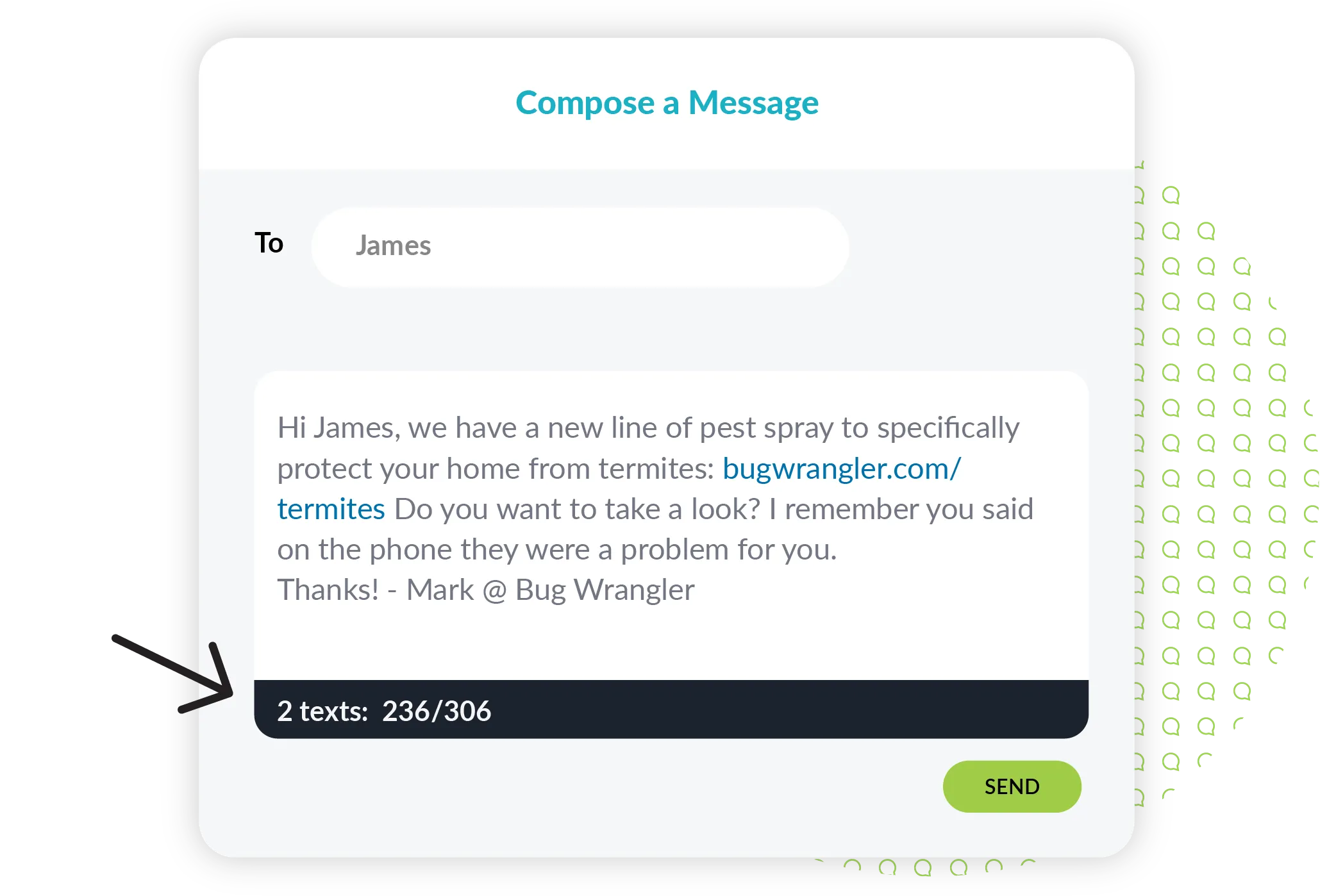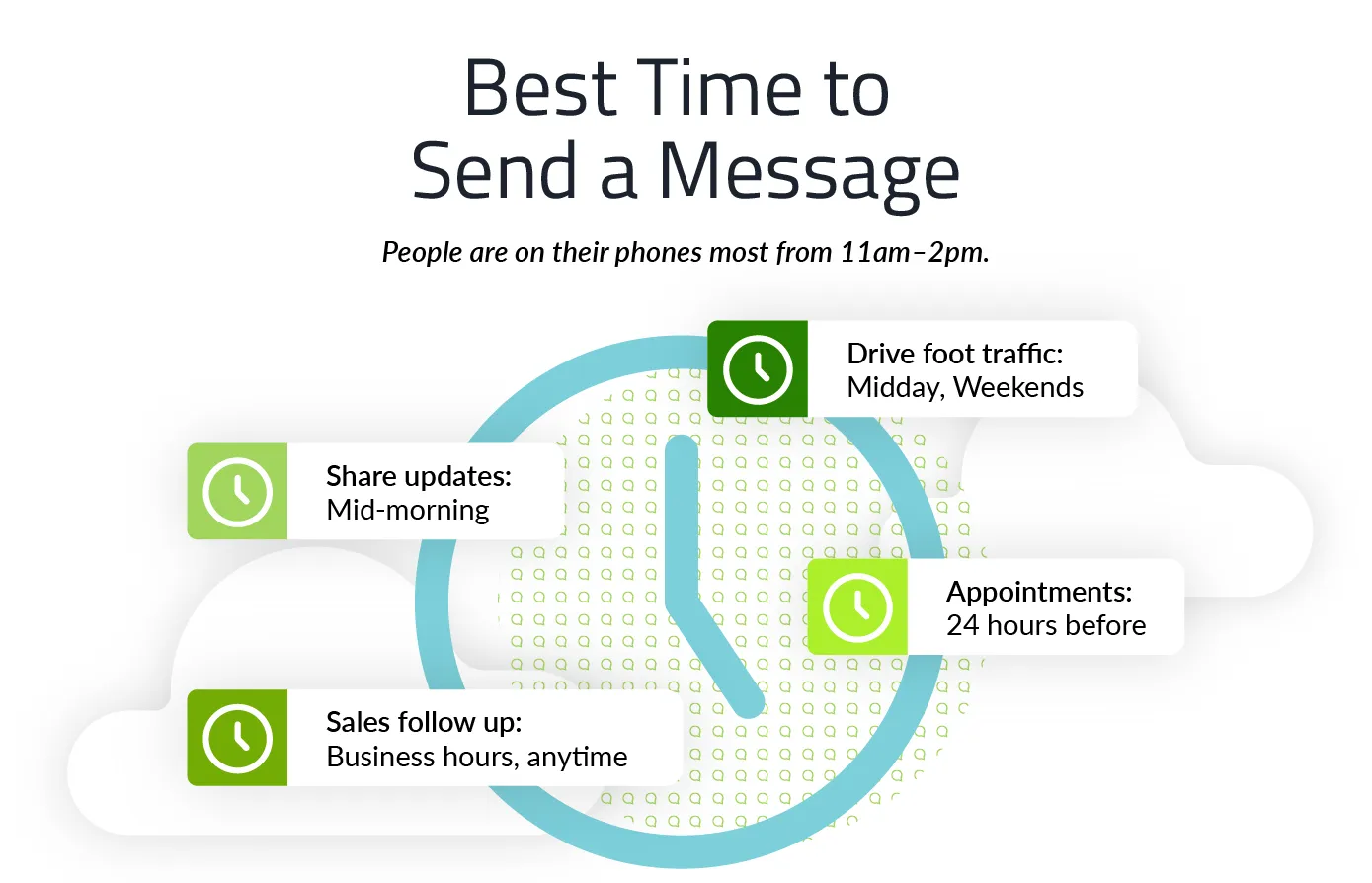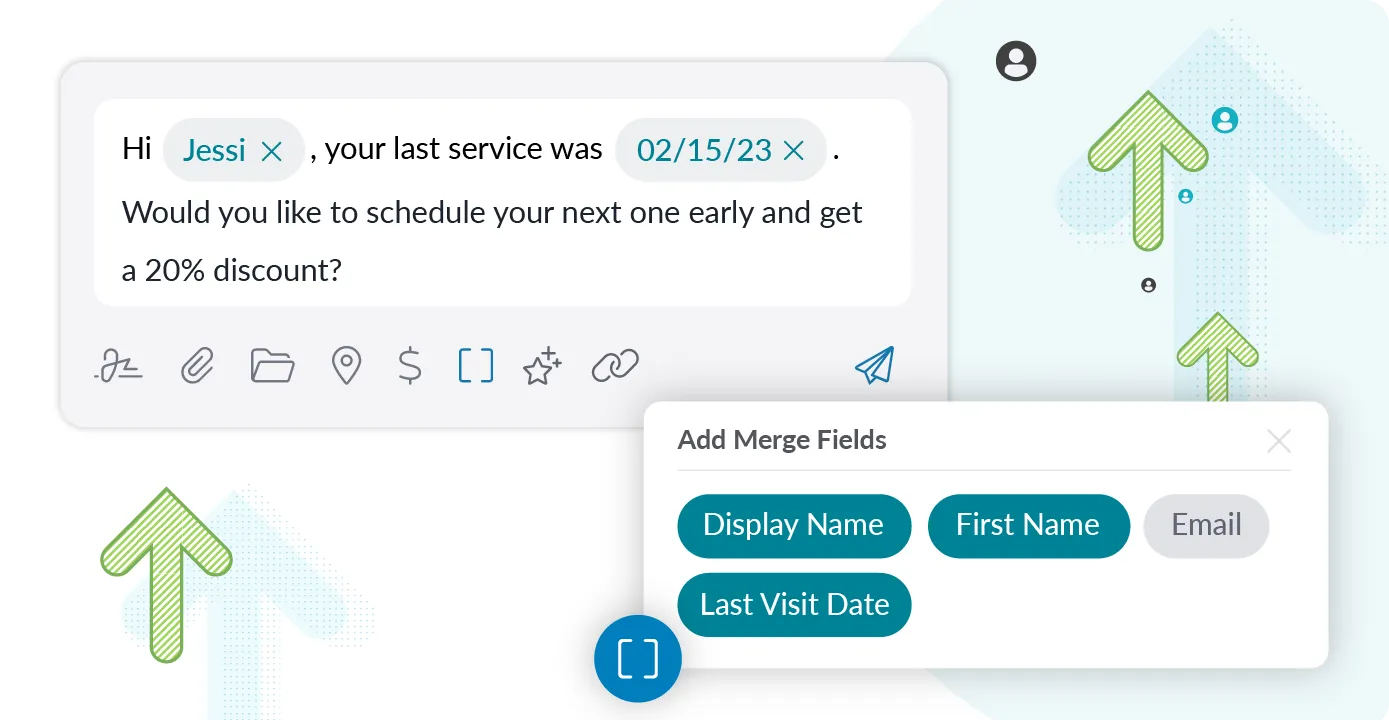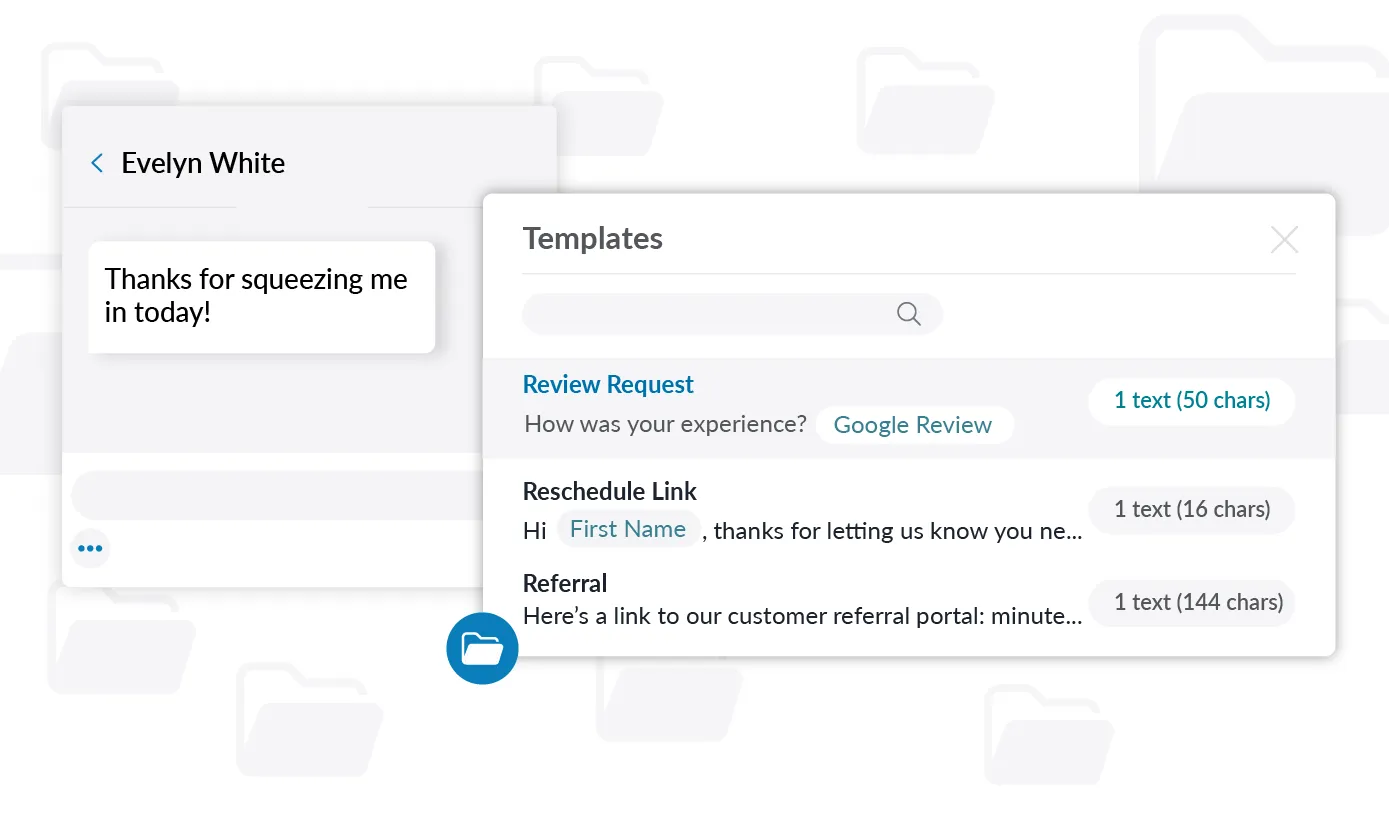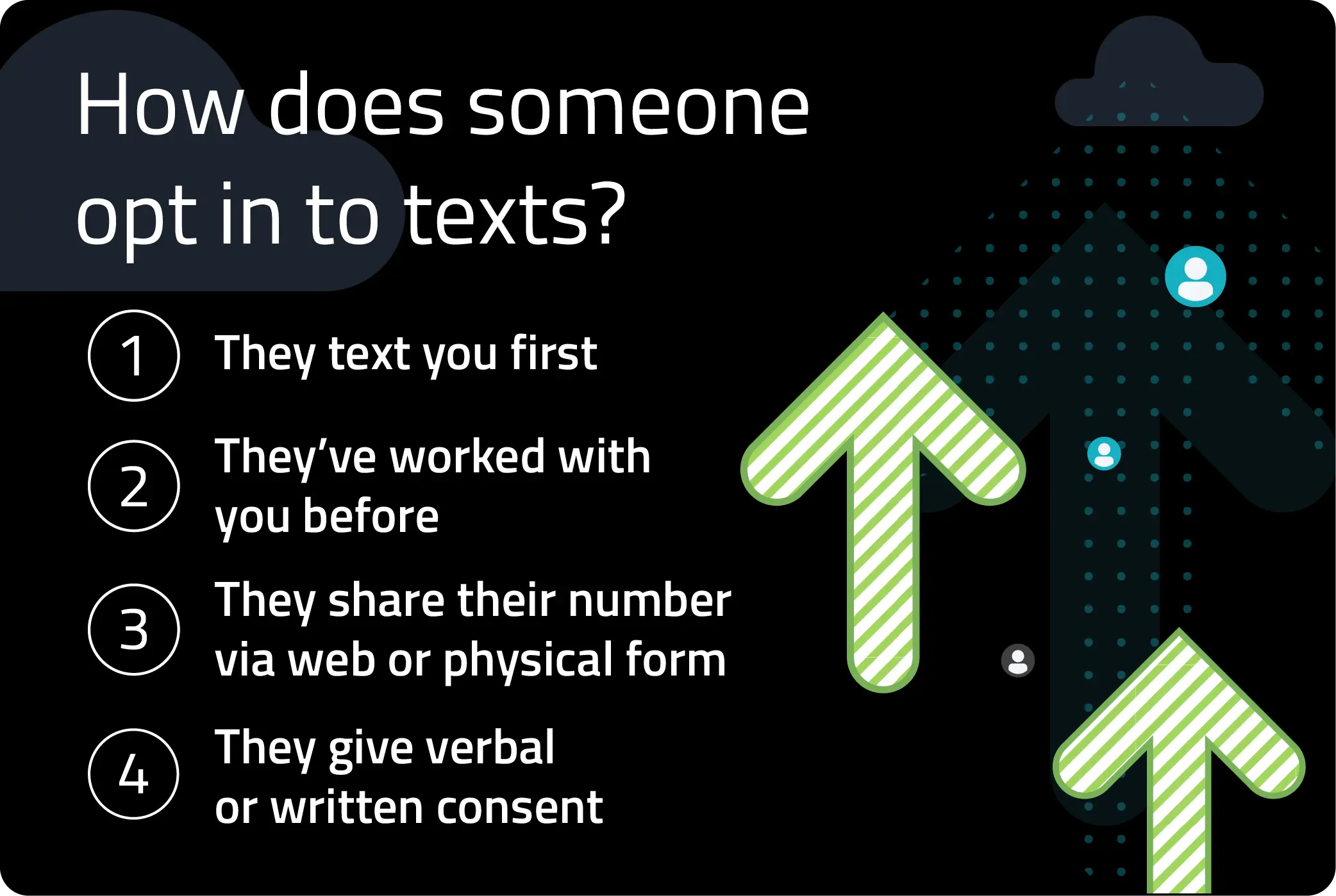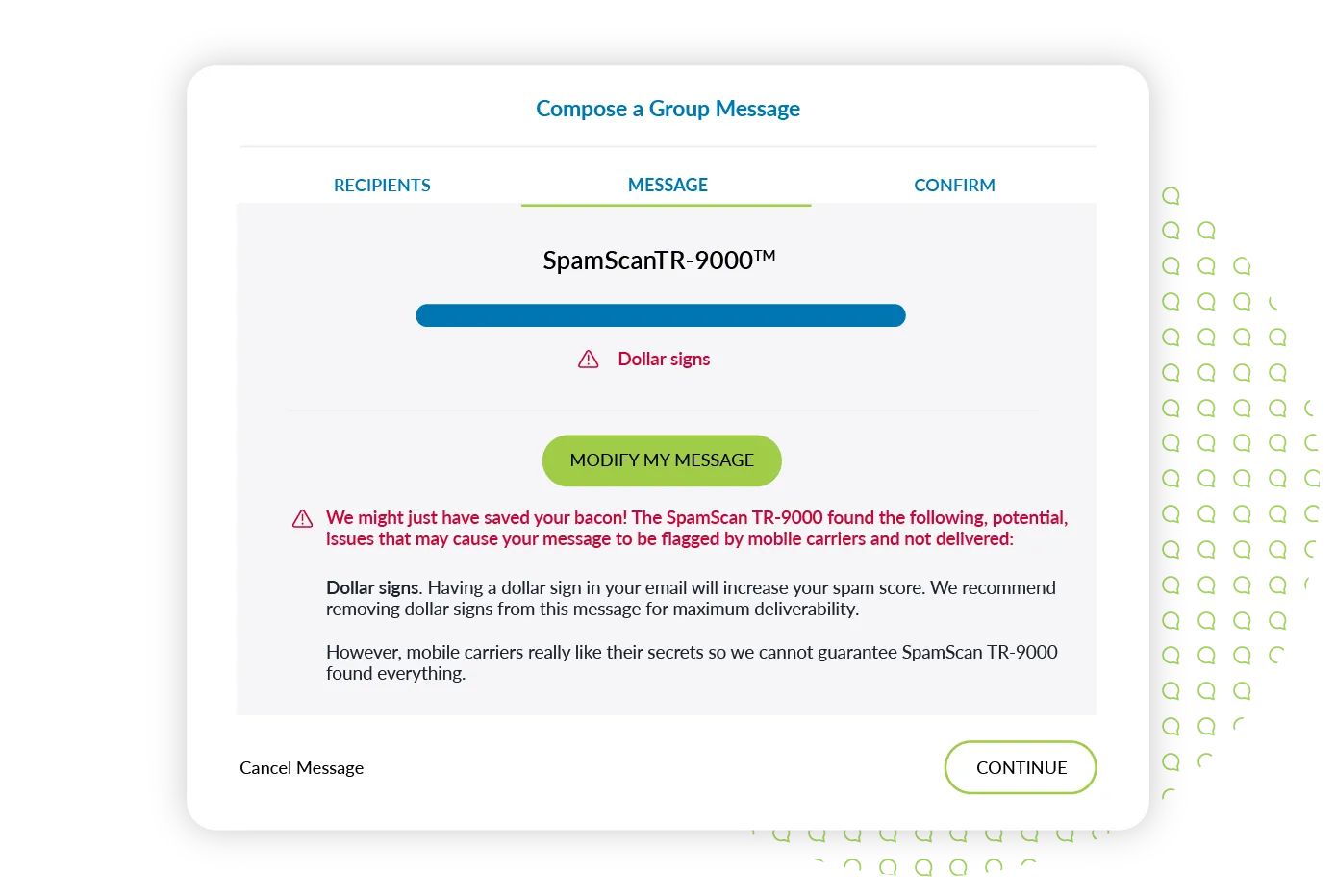Insight
How to Write Professional Text Messages Your Customers Will Love
You know text messages are seen by customers—but what should you actually say in those texts?
Below we’ll cover how to text professionally in different contexts and give you message examples for each, including:
General text messaging etiquette
Essentials for promotions and marketing texts
Advice for one-on-one texting with clients
Pointers for sending massive group or company-wide texts
Automated texts for streamlining workflow
How to use a texting service to to manage professional text conversations
Professional text message examples
How to avoid getting marked as spam
Keep reading to learn how to write professional messages that grab customers’ attention, get them to take action, and leave them feeling happy to work with you.
4 General Guidelines for Writing Professional Text Messages
These are things that any business in any industry needs to create an impactful text message.
1. Get consent before you text your contact.
How do you text someone for the first time professionally? You make sure you have consent first. Contacts can give you consent, or “opt-in” for your text messages, by:
Texting you first
Establishing a business relationship with you (making a purchase or requesting a service)
Giving you their phone number via web or physical form
Expressing verbal or written consent for you to text them
For step-by-step instructions on getting opt-ins, view our How to Build a Powerful SMS Subscriber List guide.
1. Keep your length concise.
People expect texts to be brief—they aren’t meant to be like email. So lean toward short and sweet to keep your audience’s attention.
“Hey [Name], did you get a chance to look at that link I sent you?”
Vs.
“[Name], last week I sent you a link that may help you organize your tasks, and I was wondering if you found it useful. I’d love to discuss your thoughts on if we’re heading in the right direction on your current project, plus what other useful resources I could send your way.”
Staying under 160 characters is a great rule of thumb to keep your messages concise. It’s okay to go over occasionally, but be conscious of length. We have a character counter to help you watch that number whenever you’re composing messages.
2. Communicate with customers in a casual, human voice.
No one wants another stuffy corporate communication. Customers want texts to feel like they’re coming from a real person. Mimic the way you would normally text a friend, and take those guidelines into your business texting:
Sentences don’t have to be complete
Throw in the occasional emoji when talking to customers one-on-one
Leave out unnecessary words
Don’t go overboard with abbreviations and lingo. If you have a wide audience that spans multiple age groups, you risk alienating anyone with generation specific terms.
“Get 15% off your next brick-and-mortar purchase by using the code: Cheers”
Vs.
“BING BONG. It is that time of the year again. Guess what deal we have for you this time? Give a big AYO the next time you’re in our store to get a sweet 15% discount. See you soon!”
3. Be purposeful with your send times.
Consider the scheduling of your text messages the same way you would any other marketing or communication effort. The time of day and week matter. If the customers in your industry are usually most active from 11:00 a.m. to 2 p.m.—which, spoiler alert, most are—then that’s when you should also send your texts.
We also recommend sending texts during normal business hours, especially if it’s something related to your business. You should only send a text outside of work hours if it’s related to something that needs to be handled outside of work hours, like an emergency or event. Or if your target customers are more likely to chat after hours, as is often the case for real estate and recruiting, for example.
Once you’ve nailed down when you want to send your message, you can either send your text(s) at that time, or schedule them in advance using Text Request and move on to other tasks.
Scheduling texts in conjunction with your email and social media posts is a solid way to make sure your messages are seen and stick in your customers’ minds. The more times someone sees a message, the more likely they are to take action.
Now that we’ve covered the basic musts for text messages, let’s look at specific use cases.
4 Essentials for Professional Marketing Text Messages
Marketing and promotional texts are what people refer to as SMS marketing. The goal of these messages is to get contacts to either click a link to purchase your products, or reply to the message to learn more about your services and move them through your sales funnel by doing things like:
Booking a service
Registering for an event
Giving online reviews or referrals
The big question here is:
How do you hook every person who sees your SMS marketing texts, and get them to take action?
1. Capture attention with personalization.
Customers expect texting to be a personal communication channel, so personalize your messages to them as much as possible. Use your customers’ names, and only send them messages about things you know they’ll be interested in based on previous purchases or interactions.
Merge Fields give you the power to add customizable fields, like name or last purchase, to personalize your messages. You can also put your contacts into Groups based on their specific interests and buying habits.
“Hey, [Name]! Still enjoying your [product]? We gathered a list of our other items that pair great with it. Visit [link] to view them.”
Vs.
“New sale on our latest shipment. Click [link] to see what came!”
2. Show customers why they should be hyped about your offer.
There’s one important question you need to ask when crafting marketing texts:
What value will this bring to my customers?
Use the answer to inform your message so you’ll inspire customers to take action. This may sound like a "no duh" but you’d be surprised how easy it is to forget.
Keep it simple. Maybe there’s one big thing that you need to emphasize—like the quality of the new product, or the purpose of the yearly service. Either way, make sure you include that value in your message, so customers know exactly why they need to be hyped about it.
“This time of year is common for [problem]. Visit [link] to learn how [service] can keep you ahead of the curve.”
Vs.
“We have a seasonal discount on [service].”
Too many details at once will be overwhelming, so focus on giving them one key thing to be excited about.
Including one image or emoji can also add a bit of a punch. Just make sure you only include images and emojis in messages to small groups, so you avoid getting marked as spam by carriers—which we’ll talk about more later.
3. Set a deadline for your deal to create urgency.
If you want to inspire action, you need to give people a reason to act right now, and perhaps the best way to do that is to make your offer time-sensitive. A limited time service, or an item that is low in stock, will catch your customers’ attention every time. This element should be included right after your reason why customers should be hyped for the product or service.
It’s a natural add on to get customers to take action, which leads us to our final essential for promotions and marketing text messages.
4. Point customers to the next action you want them to take.
This is the big one. You’ve put all the work into grabbing your customers’ attention. Now it’s time to direct that engagement toward the action you want them to take.
Share a link for the product or service, so they know exactly where to go.
Sound like it’s all coming together? Check out these promotions and marketing text message templates that incorporate each of the elements we talked about above.
4 Pointers For Texting with Customers One-On-One
Whether it’s for customer service, sales, or the everyday conversations that naturally come up, one-to-one text conversations between your business and a customer need to be framed differently than a promotion sent to multiple people.
Here’s what we recommend for customer service, feedback, or sales conversations.
1. Know common answers to your common questions.
Common problems require fast solutions. Make a list of the questions you get the most from customers, and write out solutions ahead of time. You can use data from your customer guides to determine which questions people are asking the most, or simply ask your sales and support reps directly.
It’s a good practice anyway to get regular feedback from your frontline workers on what questions customers are asking. Once you have your list of top questions, you can plug the answers into the Templates section of Text Request.
Templates not only help you get information to customers faster, they also keep communications consistent across employees. That helps everyone work better, faster, stronger.
2. Share pictures to stay on the same page.
Things flow faster when you know exactly what your client needs. Send pictures anytime it’d be helpful for you and the customer to both be looking at the same thing. This might be for:
Providing an estimate
Sharing documents for discussion
Parts that need replacing
Confirming work done or results
And more
If a picture’s worth a thousand words, that makes up for a lot of characters in your texts. You keep things moving and ensure no one’s time is being wasted.
3. Know when to move a conversation from text to phone call.
Whenever you’re working with people, there’s always a chance things will get complicated, even heated. We recommend moving the conversation to a phone call whenever:
The customer says they feel stuck or doesn’t understand the instructions you messaged them
You have to break heavy news, like a mistake was made, or you can’t give the customer a solution that was previously promised
The customer accuses you of something that could potentially hurt your reputation
You need to hash out something complicated or nuanced
Hearing a human voice in any of these situations is key to showing the customer you understand the weight of the situation, plus prevent any further misunderstandings from occurring. The text you use to invite them to a call could be as simple as:
“Would you like to schedule a call to keep discussing solutions? One of our reps can be available as soon as you are.”
Or
Call me when you have a sec, we’ll figure this out.
4. Use texts as a lay-up for calls.
People will ignore your phone calls unless they know when you’re calling and why. And even then it’s better to have it scheduled. We have pre-made text templates ready to go for scheduling phone call appointments like these.
Texting is the best channel for grabbing customers’ attention, but that doesn’t mean it’s the only way you should communicate with them. It should be a complement to the relationships you’re already building—a tool to help you move your business forward. There will be times when you need to bring the conversation back to a phone call, in-person meeting, or a link with more information.
3 Musts for Informational Texts and Company Updates
Sharing SMS updates and newsletters with your audience keeps you top of mind. You also need a fast way to get important company updates out that may affect customers, like office hour changes or new covid-19 protocols.
Here’s what we recommend when sending those types of informational texts.
1. Allow enough time to pass between messages.
Once a week for an SMS newsletter is enough. You want enough time to have passed so you have something valuable to share the next time.
If all your updates are just about you and what you’re doing, your customers are going to tune out. Sprinkle in some educational content, like:
Industry specific insights
Information on the best time to schedule a service or get the most out of a product
General “How To” guides
Anything your customers can use to make their lives better
Messages like these keep your audience engaged, and also help to establish you as an industry expert that customers depend on.
2. Include all relevant information for important updates.
The most important kind of info update is ones that will affect customers, like hours of operation, changes to staff or process, new offerings, or when you need customers to take an action other than a purchase or registration. We’ve talked in other sections about including links, but in these situations you want your message to contain as much of the relevant information as possible.
Once again, only send messages when you have something important to share, particularly things that can affect your customers. Do not send at a regular interval simply for the sake of sending at a regular interval. Send when you have something worth saying.
3. Only text opt in contacts.
Here’s our big note on compliance—don’t add customers to these SMS newsletters and updates without their permission. If you already have their phone number, that’s great. But give them the option to decide if they want these frequent updates by advertising them with keywords.
A keyword is a word customers can text you to be added to a specific Group for information. You can advertise these keywords on your:
Website
Social media
Email
Digital ads
All it takes is a simple call to action, like:
“Text DEALS to [business phone number] to get updates on our latest discounts and offers!”
Keywords are also useful for opting in brand new contacts for future text campaigns. This applies to all the other types of messages we’ve talked about as well.
3 Recommendations for Automated Texts
Most businesses want automated texts for appointment confirmations, payment reminders, online reviews, and sometimes as part of a marketing or sales workflow.
If what you’re trying to do falls into one of these categories, here’s what to do
1. Tell customers a real person will follow up with them ASAP.
Include the time you’ll be back in the office, if it’s an after hours autoresponse. Or let customers know they can text back to reach a real person with any questions, if it’s a scheduled appointment reminder. Or send the automated text to confirm that you got their info, and tell them someone will reach out to help as soon as they’re available.
The point is to remind customers that they’re using a personal channel, and even though the current message is automated, one of your reps is only a quick text away. It’s the kind of customer experience that will earn you more conversions, reviews, referrals.
2. Include a link for additional help or information.
Depending on the context you can also provide them with the tools to get additional information on their own with links to:
Educational guides
A calendar to reschedule or set up a new appointment
Common FAQs
Image galleries of new products
A list of your current services
This keeps prospective customers moving through your funnel, and provides current ones with valuable insights.
Text Request makes it possible to automatically shorten and track link click rates across mass texts.
3. Leave them with a next step while they wait.
Let’s say a prospective customer texts in for help after hours. They’re most likely needing something ASAP, and they’ve reached out to multiple businesses to see who responds first.
It’s one thing for them to get an autoresponse from you, but if you also include a help form or calendar to schedule an appointment, you’ll satisfy their need to take action. That will increase your chances of hooking new customers and keeping them from moving on to a competitor.
You might want to pause and focus on this for a minute. There’s a lot of money on the line here if you consistently claim customers before your competitors.
How to Use a Text Service to Manage Texting with Customers
A business texting service, like Text Request, can text-enable your current business number, so customers, prospects, and staff can reach you the way they most prefer.
Text Request enables you to text from each of your location’s business lines, so your entire team can text from the same place. Each location can have its own line, and there’s no limit to the number of users.
We also offer a host of different tools to make managing text conversations with the rest of your team a breeze.
Contact Tags: Identify contacts based on which rep they’re assigned to. Each rep can get their own custom color, so it only takes one quick glance at a Contact Tag to know who the message needs to be handed off to.
Scheduled Messages: Type a message now, then schedule it to send at a later time or date. This helps your reps to plan around their workday.
Reviews: Connect your locations’ Google Business pages to Text Request, so you can easily earn, track, and respond to online reviews all from one place. Online reviews are the #1 way people decide whether or not to work with a business.
Groups: Create groups for things like current customers, location-specific customers, use cases, and more. This is helpful not only for identification, but also for when you need to message your groups for something specific, like a new promotion or solution.
User Permission Levels: Assign your Text Request users to permission levels that fit their levels of expertise to prevent oversights.
Templates: Templates are the Text Request version of “stock” or “saved” messages. They not only help you save time, but they also keep common communications consistent across your entire team.
Keep reading for a list of text templates that you can copy and paste into your Text Request account.
12 Professional Text Message Template Examples
We’ve covered multiple ways to use text messaging professionally. Now here are some templates for each use case.
Note that these text templates are intended to be examples you use to create your own. We do not recommend directly copying and pasting them into Text Request's Templates feature, without first editing them and their [brackets] to fit your needs. These [brackets] will not automatically pull custom info and are only meant to be placeholder examples.
3 Marketing and Promotion Text Message Templates
Template 1: “Hi [First Name], new [product] dropping this Friday. [link] Place your preorder using that link.”
Template 2: “Happy birthday, [Name]! Did you know we have a special discount you can use on any of our [product or service] to celebrate?”
Template 3: “Flash sale alert! Only 10 of these discount [items] are left. [link] Open the link for details.”
3 Sales Text Message Templates
Template 1: “Hi [Name], wanted to check in after our last call. Any additional questions I can answer for you?”
Template 2: “Hey again [Name], I’ve narrowed down some different [products/services] that could help solve your problem.”
Template 3: “[Name], I know you’re slammed and trying to solve [problem]. Here’s an infographic that breaks down how we can help you. [image]”
3 Mass Customer Communications Text Message Templates
Template 1: “Our office will be closed for [event/inclement weather] starting at [time] on [date].”
Template 2: “Our new payment portal is available at [link]. Use that link to sign up for electronic billing.”
Template 3: “New guide on best practices for [service/product] is available at: [link] We’re here to help you get the most out of your purchase!”
3 Automated Scheduling and Reminder Text Message Templates
Template 1: “Thanks for completing the scheduling form on our website! One of our reps will reach out to you shortly with more details soon."
Template 2: “Hi [Name], just a friendly reminder that your appointment is at [time] today.”
Template 3: “Your payment for [services] is due on [date]. Login to [link] to pay online, or call us to pay over the phone.”
Visit our full library of text message templates here.
8 Ways to Avoid Spam Filters While Texting with Customers
Mobile carriers do spam filtering just like email service providers do, and your text messages won’t engage anyone if they get marked as spam. Plus you should avoid these common spam triggers anyways, because they’ll annoy your customers as well.
Keep in mind that using some of these triggers in individual messages will generally be fine. Carriers pay more attention as you send more messages. But including one or several of these to thousands of contacts at once is likely to land you on carriers’ naughty list.
1. Sending multiple texts that include shortened URLs.
People want to see where you’re taking them, and they can’t do that if the link has been shortened. Carriers will also get suspicious if you send a shortened link to more than 50 people at a time.
“Visit yourbusiness.com/newrelease to see our newest release!”
Vs.
“Check out this link: https://bit.ly/3Hxm66f”
You must also always avoid putting links at the end of texts—even in messages to individual contacts. We've found doing so can trigger spam filters.
2. Including ALL CAPS anywhere in your message.
It’s the equivalent of yelling. Your customers will think you’re desperate for their attention, and carriers will assume there’s something wrong. Just don’t do it.
“We have a new seasonal deal on our [service]. Visit our website to learn more.”
Vs.
“BIG SUMMER DEAL for a LIMITED time on our website. Don’t miss out!”
3. Sending images or other files to large groups.
Images are great for mass marketing messages, but only if you have a good sending reputation. That means low opt outs, high responses or clicks, over time.
If you're going to send pictures out to lots of people, ramp up your sending over time, just like you would with email marketing.
4. Using special characters in multiple texts.
Just like images, special characters and emojis are great for one-on-one conversations. But larger multiple texts including these characters will get the carrier's attention.
Dollar signs in particular have been found to trigger spam filters.
“Your payment for [service] is due.”
Vs.
“Your payment of $250 for [service] is due. 🔔”
5. The messages you send are identical to previous ones.
Using Templates can be valuable, but sending the same message to the same large list of people repeatedly is going to land you on the no fly list. Your SMS campaigns need to be varied anyways. This goes back to our point about sending messages that offer the customer new value every time.
6. You send back to back campaigns.
Space your messages out, so you don’t annoy your customers and attract the eyes of carriers. We recommend creating organized schedules for your message campaigns to help evenly distribute them.
7. The message is too long.
Once again, you’re sending a text for a reason. If it’s the size of an email, carriers are going to stop you. Your customers will also become disengaged when you send them paragraphs to read, instead of short sentences.
If the information you need to share is really detailed, redirect the conversation to a link or scheduled phone call.
“We have a guide at [link] to help with all your questions related to [feature].”
Vs.
“Our new [feature] is available in the bottom right-hand corner of your menu. You can click the button in the corner of that menu option to start setting up and entering the credentials required. These include the account you want to manage the feature, the settings you want to include, and the times you want [feature] to be active. Each of these items will be marked with a blue arrow that will change to green once you’re finished.”
8. Your message takes on a robotic or inhuman voice.
What does that mean? Atypical sentence structure or words trigger spam filters, including any grammatical errors and misspellings. If your sentences are filled with typos or sound like they were created by a wonky A.I., carriers will block you.
“Thanks for choosing [business]! How can our reps help?”
Vs.
“Thanks for chosing us today to help with your needs. send us you name and current issue and rep will get back soon”
It’s Time to Start Sending Your Own Professional Text Messages
Now that you know what to say, when to say it, and what to avoid, you’re ready to ignite customer engagement by sending professional texts your customers will love! Use the text message templates we shared throughout this post with confidence, knowing why they work and how they appeal to your customers to create the most engagement.
